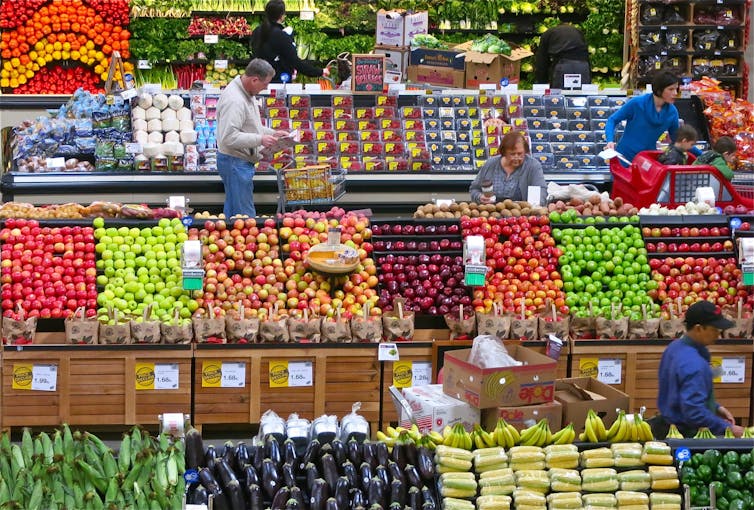Buying fresh potatoes and carrots all year round is destroying Australia's soil

Producing fresh fruit and vegetables year-round has a hidden cost.
Dean Hochman/Flickr, CC BY-SA
Bill Cotching, University of Tasmania
Have you thought about what it takes to get fresh carrots onto supermarket shelves during winter?
We all want fresh carrots rather than soft, old or bendy ones. That’s why many companies - such as supermarkets that tout their “fresh food” credentials - build their brand around providing crisp, fresh veggies all year round.
Unfortunately, consumers’ expectations that certain types of produce will always be available mean that farmers must engage in unsustainable and destructive practices.
Carrots are collected using mechanised harvesters, heavy tractors and trucks. In winter, during seasonal rainfall peaks, the combination of wet earth and heavy machinery results in severe soil compaction and soil structure degradation.
Studies have shown that this degradation can last for decades. This reduces the soil’s fertility and ultimately reduces crop yields.
Soil degradation
Soil degradation has serious impacts on the sustainability and profitability of Australian farms. A 2004 Tasmanian study found that soil degradation reduced potato and poppy crop yields by up to two-thirds. Carrots and potatoes are not alone in winter soil degradation; broccoli, cabbages and peas are often harvested when soils are too wet.
The other three main issues of degradation are declining soil organic matter levels, soil loss by erosion, and nutrient imbalances.
Soil organic matter plays a fundamental role in soil’s physical, chemical and biological processes, but its decline under Australian agriculture has been well researched and widely reported.
The use of green manure cover crops (crops that aren’t harvested) and grass pastures in rotations that provide greater organic matter residues can help. But farmers may struggle to afford the ongoing investment required to improve long-term sustainability.
Whether caused by wind or water erosion, soil loss is permanent. Heavy losses occurred in Sydney, Brisbane and Canberra in 2009, and Melbourne in 1983. The fine particles and organic matter lost in dust storms are the most important for soil fertility.
As former Nebraskan governor Bob Kerrey once said:
If you run out of water, you pray for rain. If you run out of soil, you pray for forgiveness.
The third element is soil nutrients. The main factors here are soil pH, plant-available phosphorus, potassium and sulphur. A study of 1,700 intensively grazed pasture paddocks found that only 3.7% had the optimum balance for pasture production. More than 40% had too much phosphorus and potassium.
Intensive farming means increased amounts of nutrients and sediment end up polluting off-site surface water. Nutrient loss at catchment scales has been reported in southeastern Australia, with phosphorus losses of 10’12kg per hectare per year and nitrogen losses of 20’30kg per hectare per year, which are at the higher end of published values.
However, these losses may be under-reported by as much as 50%, as the sampling misses flood events. Land management is important to reduce the total nutrient and sediment delivery to rivers. But even with the best management practices, nutrients and sediments will still be delivered at higher than natural rates.
A better way
Some solutions to this problem lie in better technology and education. For example, using the right fertilisers at the right time can help with nutrient imbalances.
GPS guidance on agricultural machinery can restrict damage to soil structure to strict lines in paddocks (known as tramlines). This technology is increasingly used across a range of cropping industries, but there are significant barriers to its universal uptake in the vegetable industry.
It is important to remember that simply making information available, especially via online portals, will not necessarily result in farmers adopting sustainable practices. Farmers often need to trust those with new ideas before change happens.
But the other part of the solution is consumer demand. The pressure on our natural resources is mounting. Projected increases in global food demand over the next 50 years pose huge challenges for sustainable production.
 While many shoppers want their food to be sustainably grown, we also generally expect certain produce ’ carrots, potatoes and broccoli ’ to show up, gleaming fresh, in our supermarkets. Understanding the cost of off-season harvesting, and separating the ’fresh food’ marketing from reality, is the first step to more sustainable consumption.
While many shoppers want their food to be sustainably grown, we also generally expect certain produce ’ carrots, potatoes and broccoli ’ to show up, gleaming fresh, in our supermarkets. Understanding the cost of off-season harvesting, and separating the ’fresh food’ marketing from reality, is the first step to more sustainable consumption.
Bill Cotching, Soil scientist, University of Tasmania
This article was originally published on The Conversation. Read the original article.
___________________
 ___________________
___________________
Some related links
The White Hat Guide to Potatoes